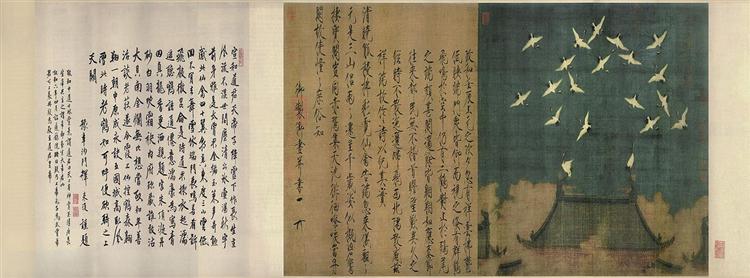Description
The painting "Auspicious Gullas - 1112" of Emperor Huizong constitutes a fascinating visual testimony of the refined aesthetic of the Song dynasty (960-1279), a historical period characterized by an outstanding artistic and cultural flourishing in China. This work is a sublime manifestation of the confluence between politics, nature and spirituality in Chinese art.
Emperor Huizong, an artist and calligraphy fan as well as ruler, is known for having developed a detailed and elegant pictorial style. "Auspicious cranes" is emblematic of this trend, presenting twenty cranes in various positions, some in full flight and other inns, around the imperial palace. The nature of cranes in Chinese culture symbolizes longevity and good fortune, which makes this scene an omen of prosperity and harmony.
The composition of the painting demonstrates a thorough balance and dynamism. The cranes are distributed with a careful symmetry that guides the viewer's view between the terrain and the sky. The use of negative space, typical of Song painting, creates an atmosphere of serenity and amplitude. The background presents a palatial architecture with angular and detailed roofs, which account for the imperial environment. Grullas unfold on these architectural elements, highlighting the harmonious relationship between what is built by man and nature.
The use of color is moderate but effective. The palette focuses on soft and terrible tones, with black and white details that stand out to cranes. Chromatic sobriety is a conscious choice that underlines elegance and calm inherent to work. This use of color also highlights the meticulousness in the details, evident in the feathers and anatomical characteristics of the cranes, which populate the space with an almost tangible naturalness.
A remarkable aspect of this painting is the incorporation of calligraphy, another ability for which Huizong is renowned. The inscriptions present in the painting reinforce the auspicious message of the painting and add an additional layer of symbolic depth. Calligraphy is not only an ornament, but an integrative component that unifies image and word in a coherent conceptual framework. The calligraphic style of Emperor Huizong is recognized for its elegance and precision, evidencing a mastery that complements its pictorial ability.
The "auspicious cranes" is not only a work of visual art, but also a significant historical document. The context in which it was created in a time where beliefs in omens and symbols were fundamental in the legitimation and stability of power amplifies its importance. The cranes that appear in the Imperial Palace can be interpreted as a sign of heavenly backup to the reign of Huizong, a divine legitimation that reinforces the image of the emperor not only as a ruler but as an intermediary between heaven and earth.
In the widest panorama of Chinese art, this work is within a tradition of paintings of birds and flowers that reached their cusp during the Song dynasty. Contemporary and subsequent painters were influenced by the naturalistic precision and the poetic lyricism of Huizong. This approach had a enduring impact and modeled future artistic expressions in China.
"Auspicious cranes - 1112" is, in short, a milestone of ancient Chinese art. The combination of its technical, symbolic and contextual aspects makes it an invaluable work that continues to resonate over time, offering a window to the cultural splendor of the Song dynasty and the life of one of its most illustrious emperors-artists.
KUADROS ©, a famous paint on your wall.
Hand-made oil painting reproductions, with the quality of professional artists and the distinctive seal of KUADROS ©.
Art reproduction service with satisfaction guarantee. If you are not completely satisfied with the replica of your painting, we refund your money 100%.

